William E. Brown, 2003–2013
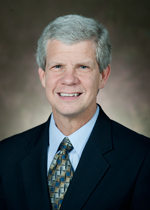
Cedarville’s ninth President, Dr. William E. Brown, came to the University following a presidency at Bryan College in Dayton, Tennessee. He is a graduate of the University of South Florida, and he received his Th.M. in theology and Ph.D. in biblical studies from Dallas Theological Seminary. He is also the author of three books on worldview, and he developed a worldview media curriculum called re:View.
Dr. Brown articulated Cedarville’s mission as “a Christ-centered learning community equipping students for lifelong leadership and service through an education marked by excellence and grounded in biblical truth.” His chapel themes regularly explored how to center your heart, mind and life on Christ.
A hallmark of Dr. Brown’s tenure was the development of new online programs and the launch of graduate programs including the PharmD, MEd, MSN, and MBA. These programs were part of a strategic plan, called Vision 2020, that focused on expanded student markets, increased scholarships and financial aid, and reduced financial dependence on student tuition.
The physical campus expanded to include the Center for Biblical and Theological Studies and Health Sciences Center, and 14 residence halls were renovated. In 2012, the University celebrated the 125th anniversary of Cedarville’s 1887 charter.
Dr. Brown and his wife, Lynne, were deeply involved in students’ lives. They regularly hosted student groups and gatherings in their home and mentored engaged couples in the “Fit to be Tied” program. Lynne established Women for Scholarship to raise funds for students with financial need. Students appreciated Dr. Brown’s approachability, genuine care, and quick wit.
Paul H. Dixon, 1978–2003
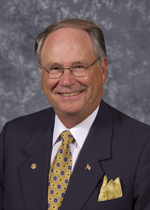
Dr. Paul H. Dixon became the eighth president of Cedarville College in 1978. A graduate of Tennessee Temple University and Temple Baptist Theological Seminary, Dr. Dixon spent 14 years as an evangelist before becoming president. In 1986, while president, he earned his doctorate in higher education from the University of Cincinnati. He also holds an honorary doctor of divinity degree from his alma mater, and the honorary doctor of laws degree from Liberty University in Lynchburg, Virginia.
A glance at the 25 years of Dr. Dixon's presidency reveals great achievements for Cedarville University. But Dr. Dixon would be the first to say that the only explanation for Cedarville is God. The success of the University may be due in part to Dixon's God-given ability to balance stability and change. Without fail, Dixon has kept the University in step with its credo — "for the Word of God and the testimony of Jesus Christ" — and its mission — "to provide an education consistent with biblical truth." Faculty and staff have named his strong emphasis on chapel and his challenging sermons as two of the most significant characteristics of his presidency. His evident, passionate desire for students to take part in the Great Commission never waned. Under Dr. Dixon's leadership, daily required chapel continued to be a priority on campus.
Yet the very opposite of stability — change — has been another building block of Dr. Dixon's tenure. With a strong vision and a strategic plan in hand before he even began his job, Dixon has led the University into tremendous growth. In his 25 years, $100 million in facilities have been built on a campus that has expanded from 180 acres to 400. Cedarville attained university status in 2000 and offers more than 100 programs, including graduate degrees. Enrollment has blossomed from 1,185 students in 1978 to more than 3,000, and the faculty has grown from 60 to 203. As well, the University's focus on technology positioned it as a leader in the digital age.
As Dr. Dixon came to the conclusion of his 25 years as president, he modeled the life verse which he and his wife, Pat, chose: "The steps of a good man are ordered by the Lord, and he delighteth in his way" (Psalm 37:23). In May 2003, Dr. Dixon became the Chancellor of the University, as the mantle of the presidency was passed to William E. Brown, formerly the president of Bryan College in Dayton, Tennessee. The Dixon Ministry Center, opened in 1996, was named in honor of Paul and Pat Dixon.
James T. Jeremiah, 1954–1978
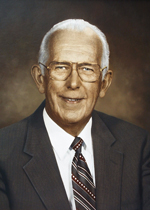
Dr. James T. Jeremiah, born in New York in 1914, graduated from Baptist Bible Seminary in Johnson City, New York, in 1936. Dr. Jeremiah assumed his first pastorate in Panama, New York, followed by a move to the Emmanuel Baptist Church in Toledo, Ohio, in 1939. In 1950, he began his service as the pastor of the Emmanuel Baptist Church in Dayton, Ohio. It was while serving in Dayton that Dr. Jeremiah became aware of the plight of Cedarville College in Cedarville, Ohio, whose trustees in 1953 were looking for a merger with another institution or another group to assume the responsibility for the College, given it was on the verge of closing. At the same time, the Baptist Bible Institute of Cleveland was searching for another property to which they could move to ease crowdedness and to expand to a four-year college program. Dr. Jeremiah's service on the Board of Trustees of the Baptist Bible Institute and his awareness of the availability of the Cedarville College campus led him to be instrumental in the decision by Baptist Bible Institute of Cleveland to merge with Cedarville College, taking over an institution with declining enrollments and increasing debt.
Though reluctant to leave the church ministry he loved, Dr. Jeremiah was finally persuaded to take over the leadership of Cedarville College in 1954, now under Baptist direction after its 66 years under the Presbyterians. With Dr. Jeremiah's servant leadership, the College began the transformation from a struggling school to an accredited institution of higher learning respected for its graduates, programs, faculty, and facilities. College enrollment steadily increased during Dr. Jeremiah's tenure, reaching more than 1,200 by the mid-1970s. This transformation of the institution also included the expansion and development of the campus with major new facilities being constructed and additional land being purchased for future growth.
During his tenure as the President of Cedarville, Dr. Jeremiah earned an undergraduate degree in history from Central State University in 1961, a Master of Arts degree form Winona Lake School of Theology in 1968, and he was awarded the honorary Doctor of Letters degree from Cedarville College in 1974. Dr. Paul Dixon, Cedarville's eighth president, said of Dr. Jeremiah at the time of his death in 2000, "Dr. Jeremiah has been 'Mr. Cedarville' for the past 47 years. He provided the vision and energy to transform a struggling college into an institution of higher learning that attracts some of the brightest and most committed Christian young people in America." Dr. Jeremiah stepped down as president in 1978, and assumed the role of Chancellor, which he held until his death in August 2000. The Jeremiah Chapel in the Dixon Ministry Center is named in honor of Dr. James T. Jeremiah.
Leonard Webster, 1953–1954
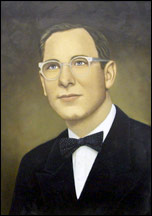
Dr. Leonard Webster, the Dean of the Baptist Bible Institute of Cleveland, was selected as President of the Institute in 1953. Thus, when the merger with Cedarville College was completed, he became the new president of the College. Dr. Webster was soon thrust into managing the move from Cleveland to Cedarville, assuring a student body for the fall of 1954, and finding a faculty for the College to complement the faculty of the Baptist Bible Institute. In his brief tenure as president, Dr. Webster represented the College at the national and State of Ohio conferences of the Regular Baptist Churches to promote the College and to raise the necessary funds to keep it solvent. The stresses of this transition and of a developing leadership crisis led to the resignation of Dr. Webster in June 1954.
E. H. Miller, 1950–1953
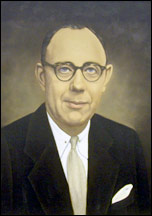
Following the resignation of Ira Vayhinger as President, the Business Manager of the College, Mr. E. H. Miller was appointed as President. It was while Mr. Miller was President that Cedarville, in order to sustain the viability of the College, continued to actively seek a merger with another institution or to invite the assumption of operations by other church denominations. Without such actions, it appeared that the College would be forced to close at the end of the 1952–53 academic year. It was during early 1953 that the Baptist Bible Institute of Cleveland, looking for larger quarters for its growing program, made an offer to merge with Cedarville College and assume control not only of the charter and campus of the College, but also of its growing debt. Following the unanimous vote of both Boards of Trustees to implement the merger, the transfer was completed on April 4, 1953. At that point E. H. Miller's tenure as president ended.
Ira D. Vayhinger, 1943–1950
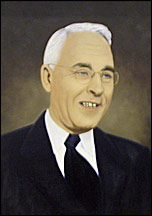
Following the sudden resignation of the third president, Walter Kilpatrick, in 1943, the Board of Trustees selected Ira Vayhinger as the College's fourth president. Mr Vayhinger had graduated from Evansville College in 1910, and had done graduate work at Oberlin Theological Seminary from 1910–1911. He had served as General Secretary of the Young Men's Christian Association from 1911–1922. From 1923–1941, he had been a church finance consultant and campaign director, coming to Cedarville College in 1941 to become the Finance Director and Business Manager. It was Mr. Vayhinger's task to attempt to guide the College through the challenging years of World War II, when it was a struggle to maintain enrollments and financial stability. However, despite attempts to raise additional funds and to expand enrollment, the deepening financial crisis led to the resignation of Mr. Vayhinger in 1950.
Walter Smith Kilpatrick, 1940–1943
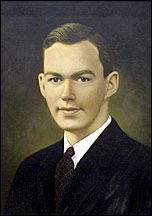
The Rev. Walter Smith Kilpatrick was selected by the Board of Trustees in 1940 to replace Dr. McChesney. Rev. Kirkpatrick had graduated from Cedarville College in 1934 with honors. He studied for the ministry at Western Theological Seminary in Pittsburgh where he again graduated with honors and received an award to study in England. Following that opportunity, he spent a semester at the University of Basil in Switzerland. In addition, he received a Master of Arts degree from the University of Pittsburgh and completed his residency for the Doctor of Philosophy degree at Pittsburgh. Kilpatrick was inaugurated on October 4, 1940, a gala occasion which included an address at the inaugural dinner by the governor of Ohio, John W. Bricker. Kilpatrick's brief tenure as president was plagued by growing financial difficulties, made more difficult by the impact of World War II. In October, 1942, Kilpatrick asked for a leave of absence to serve overseas with the European Student Relief Fund, leaving the operation of the College in the hands of the Business Manager, Mr. Ira Vayhinger, who would serve as Acting President. Kilpatrick departed the College in early 1943, but, because of some personal difficulties, he did not complete the overseas assignment, and he also resigned as President in February of 1943.
Wilbert Renwick McChesney, 1915–1940
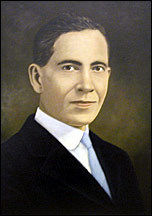
Dr. Wilbert McChesney, born in Pennsylvania in 1871, attended Greersburg Academy and graduated from Franklin College in 1892. Following his graduation, he taught Latin and History at Franklin for two years and in 1894 became the first professor at Cedarville College when the doors officially opened for classes. He received his Masters and Doctor of Philosophy degrees from Franklin College and a Doctor of Divinity from Tarkio College. Dr. McChesney served at Cedarville, not only as a faculty member, but also as Secretary of the Faculty, Vice President, and Dean. In 1915, upon the retirement of Dr. David McKinney, Dr. McChesney was named the second president of Cedarville. For a period of time, the Reformed Presbyterian Seminary was also located at Cedarville, and Dr. McChesney served the Seminary as professor of New Testament literature and later as professor of systematic and pastoral theology. Dr. McChesney commanded the respect of his denomination and of his community. In addition to his ministry at Cedarville, he served seven terms in the Ohio Legislature. He led the College during very difficult days during World War I and the Depression. Even so, one historian described those years at the College as the "golden years." As Dr. McChesney approached 70 years of age, the pressures of the Office of President and the desire for a younger man to assume the responsibilities of the administration led him to submit his resignation on June 1, 1939. It became effective in 1940 upon the appointment of Walter Kilpatrick as the third president of Cedarville. When an alumnus of the class of 1908 was asked his opinion of Dr. McChesney, he immediately responded, "He was the finest man ever connected with Cedarville College." At the completion of his 25 years as president, Dr. McChesney had served Cedarville College for 46 years. McChesney Hall, a residence hall constructed in 1999, was named in honor of Dr. McChesney.
David McKinney, 1894–1915
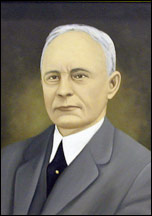
The Rev. Doctor David McKinney was born in Philadelphia in 1860. He was educated in the Philadelphia public schools, the University of Pennsylvania, and the Reformed Presbyterian Theological Seminary. He also was awarded the Doctor of Divinity degree from Wittenberg College in 1895. The General Synod of the Reformed Presbyterian Church elected him first president of Cedarville College in 1894. While president, he continued to serve his congregation in Cincinnati and commuted by train to Cedarville twice weekly to provide leadership in the development of a fledgling institution. Dr. McKinney was known for his energy and determination to see the College well established. He knew every student personally and was known as an inspiring speaker and a man of great intellectual ability. After resigning from the presidency in June of 1915, Dr. McKinney continued as President Emeritus and Trustee until his death in 1934. McKinney Hall, a residence hall constructed in 1999, was named in honor of Dr. McKinney.
















